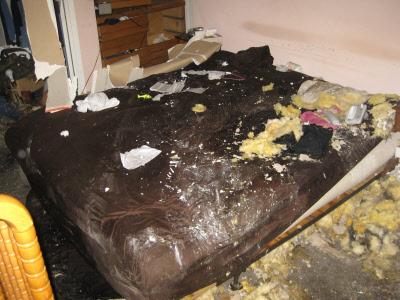Fire Resistant Wool Mattress Products
Sleep Safe with Quality, Toxin-Free Bedding
For years, mattresses, pillows, and other bedding products have been the perfect source of kindling for house fires. Space heaters and smoking materials are the main cause of bedroom fires. To prevent injury and death from these fires, the Consumer Product Safety Commission enacted standard 16 CFR 1633: mattresses must be flame-resistant.
While this standard has reduced bedroom fires, it has an unintended side effect: exposing families to dangerous, toxic chemicals whenever they sleep. Fortunately, wool mattresses from The Wool Bed Company™ have a natural resistance to fire without these toxins.
What Chemicals Make Non-Wool Mattresses Fire Resistant?
Non-wool mattresses need to use highly toxic flame-retardant chemicals like polybrominated diphenyl ether, known as PBDEs, to meet government safety standards. PBDEs, which have been banned in Canada, Europe and several states, build up in your body over time, and are associated with health problems including brain and reproductive damage, decreased sperm quality, thyroid problems and even cancer at high levels.
These chemicals have become incredibly pervasive. PBDEs are not only in mattresses, they’re also in furniture and countless other household products. The result is almost constant exposure to these dangerous toxins. Not surprisingly, the chemicals are now showing up in breast milk, blood tests and even umbilical-cord blood and livers of fetuses.
Other flame-retardant chemicals currently approved for use in mattresses include:
- Boric acid, a toxic respiratory irritant used to kill roaches
- Antimony, a metal that may be more toxic than mercury
What is Boron?
Boron is used in a range of industries, as a dopant, abrasive, and ingredient in propellant mixtures, among other things. Pure boron is not itself harmful, although many of the forms in which it appears are toxic or somewhat toxic. It may naturally appear in blends of toxic material, which can make handling some forms of boron rather harmful. In addition, boron extraction generates harmful waste, since it must be heavily treated to extract a usable pure form. Even when this material is handled responsibly, it represents a potential environmental problem, as toxins are difficult to break down into a safe and stable form.
What is Antimony?
Antimony resembles arsenic very closely; the difference in its behavior being almost entirely accounted for by the fact that antimony is slightly more metallic. This helps explain why it is so poisonous.
The Center for Disease Control (CDC) cannot determine a safe level of antimony exposure because:
“At the lowest exposure levels tested, the adversity of the effects was considered to be serious.”
In their Jan-06 Risk Assessment the Consumer Product Safety Commission (CPSC) shows the average adult will absorb a daily dose of .802 mg of antimony, .081 mg boric acid, and .073 mg DBDPO (Deca) from flame proof mattresses every night. Five-year-old children will absorb .5 mg antimony every night, 63 times more poison than the EPA says is safe. Younger children were not studied. On cancer risks of antimony even the CPSC admits: “The cancer effects are cumulative. Every exposure contributes to the overall lifetime risk of developing cancer.”
What is Boric Acid?
Boric acid is used as roach killer and in fiberglass manufacturing. For humans, it is a known reproductive and developmental toxin, a known respiratory irritant, and has demonstrated injury to the gonads and in developing fetuses. Neonatal children are unusually susceptible and there is a corresponding high prenatal mortality rate. There are already 6,463 U.S. cases of boric acid poisoning each year. One human exposure study showed reduced sperm counts and reduced sexual activity in humans.
What Laws Are in Place To Protect Consumers When Buying Mattresses?
On July 1, 2007, a new government law was passed by the CPSC mandating the use of flame retardant chemicals in ALL consumer mattresses sold in America, including crib mattresses! The purpose of this law is to reduce the risk of fire injury BUT the flame retardant chemicals used in mattresses today are potentially dangerous and toxic to all humans, especially newborns.
These harsh chemicals can combine with a common household fungus (often found in mattresses) and lead to the production of toxic and deadly “nerve gases” that can have catastrophic consequences for a newborn. In some cases, this can be toxic enough to shut down a baby’s breathing in literally minutes, leading to SIDS.
Chemicals added to mattresses to meet the fire retardant standards do NOT have to be disclosed in any way. The mattress must just meet the fire retardant standard! Consumers who want to buy a mattress may have no way of knowing exactly what chemicals they’re getting.
How are Wool Mattresses Meeting Fire Retardant Laws without Chemicals?
Wool fiber is less susceptible to burning than synthetic fabrics. As a result, it can be used in bedding without the need for flame-retardant chemicals.
How effective is fire-resistant wool? The US Military, through extensive studies as reported by Agricultural Research, use wool for uniforms and protective gear due to its natural resistance to fire.
"Wool burns with a self-extinguishing flame and produces a soft ash that dissipates and will not lodge in open wounds," says Jeanette M. Cardamone, a chemist at the ARS Eastern Regional Research Center (ERRC) in Wyndmoor, Pennsylvania. “Synthetic materials, on the other hand, form hot, molten beads that can drip into a wound and cause trauma.”
Increasing the value and versatility of domestic wool would benefit the U.S. sheep industry, which produces about 40 million pounds of raw wool a year. In addition, U.S. consumers—including the U.S. military and many law-enforcement agencies, which are required to use domestic wool in their uniforms and equipment—would enjoy the benefits of home-grown, soft, shrink-proof, fire-retardant wool.
 Facts About ECO-Pure™ Wool Mattresses
Facts About ECO-Pure™ Wool Mattresses
It is important to mention no mattress is 100% fire-proof. While wool and other bedding materials are tested and approved for flame-retardant properties, the right combination of factors can still set any mattress ablaze.
To reduce the risk of mattress fires, keep open flames and heat sources away from your bedding. Lit candles and fireplaces should not be left unattended. And while you may enjoy some extra warmth from a space heater or electric blanket, keeping them on too close to the bed can have deadly consequences.
The Wool Bed Company™ mattresses, toppers, and pillows are made without toxins, dyes, or chemical detergents. Sleep clean and safe on our organic bedding.






